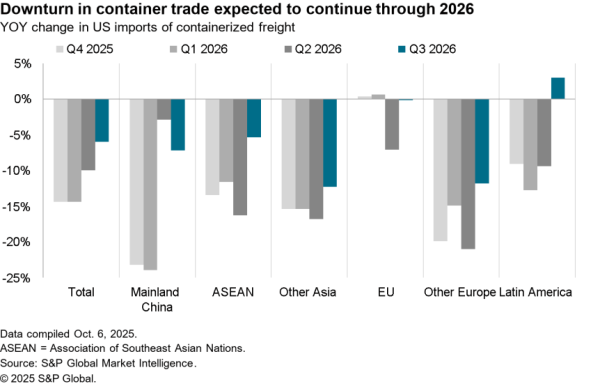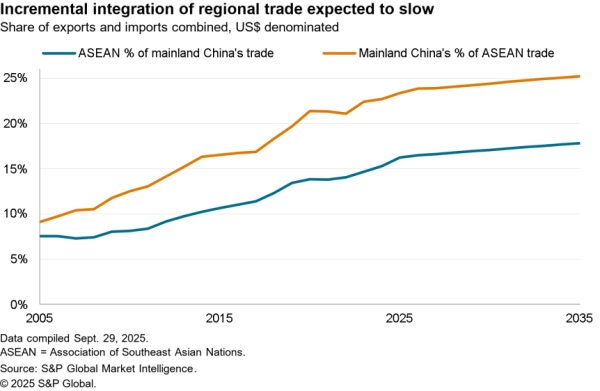The past 18 months has been something of a golden age for international trade deal-making, as discussed in Panjiva research of Dec. 20, with the passage of CPTPP in Asia, bilateral deals involving the EU, Canada and Japan and continued progress in a series of multilateral deals.
The outlook for 2019 is not as bright.
Brexit – The £264 billion question
The year starts with the very real prospect that the European Union will lose a member for the first time on Mar. 29 as Brexit formally takes place. The potential for the U.K. leaving without a withdrawal agreement – covering customs arrangements – or political agreement for future trade negotiations face yet another “deadline” with a vote in the British parliament from Jan. 14. EU Parliament elections in May and the advent of a new Commission in November will only complicate matters going forward.
Panjiva analysis of official data shows the EU accounted for 70.8% of Britain’s £39.3 billion ($49.5 billion) of food imports in the 12 months to Oct. 31, 76.8% of its £24.9 billion of medicines and 54.2% of its £10.6 billion in raw materials. For context the EU in total accounted for 54.4% of Britain’s total £486.2 billion in imports over the same period. Shipments of those products face potentially significant disruptions should adequate customs arrangements not be put in place in time.

Source: Panjiva
Asia – CPTPP+ may beat RCEP if South Korea Jumps Ship
The activation of the CPTPP trade deal on Dec. 30 was one of the major trade highlights for international trade policy in 2018. So far South Korea is the largest country with a firm interest in joining the 12-member group though China and even the United Kingdom (post-Brexit) have also been linked with potential negotiations.
That may complicate the ongoing negotiations relating to the China- and ASEAN-led Regional Comprehensive Economic Partnership deal. While RCEP is “simpler” in being focused on goods and tariffs its geographic scope may be proving a hinderance.
Indeed if South Korea joins CPTPP then China may be better off reorienting its focus on CPTPP given it would more assuredly gain a trade deal with Japan and potentially South Korea which represented 37.7% of its exports to the RCEP group in 2017, Panjiva data shows. Other CPTPP members including Vietnam, Singapore, Malaysia and Australia (31.7% together) are also part of RCEP negotiations.
The main missing piece would be India (10.7%) where there have been frictions with China due to India’s tariff-led industrial policy. China does not appear to have given up on India, or RCEP just yet though.

Source: Panjiva
India – Vote in India vs. Make in India
The steady expansion of the “ Make in India” strategy by the administration of Prime Minister Narendra Modi has begun to yield modest benefits in slowing the growth in imports of electronics – imports of electronics rose by just 0.3% on a year earlier in November. The biggest swing factor in its further development may relate more to politics than economic though.
Elections at both the national and regional level in April and May may lead the Modi administration to cut import tariffs temporarily as a route to reflation – much as the Chinese government has followed recently.
Any signs ahead of the elections that there may be a change in government may also lead companies to slow investments planned in response to the “Make in India” tariffs. Major importers of capital goods and electronics (HS chapters 84 and 85) that face such uncertainties include Samsung Electronics – which has cut its imports by 20.4% in the 12 months to Sept. 30 on a year earlier – Siemens (down 8.6%) and Schneider Electric (up by just 0.2%).

Source: Panjiva
Metals – The need for a real steel deal
The fallout from the U.S. implementation of 25% duties on steel imports and 10% on aluminum imports, introduced in two phases in March and June 2018, is still being felt across the industry globally. One response has been the implementation, or at least investigation, of similar “safeguarding” measures to tackle an influx of metals that had otherwise been bound for the U.S.
Both the European Union and Canada have applied their own restrictive measures to try and deal with increased exports from China in particular. In Europe’s case that has not been successful. Panjiva analysis of Eurostat data shows EU imports of steel from China rose 18.3% in the three months to Oct. 31 on a year earlier while total imports rose 15.4% to 85.5 billion euros ($96.8 billion) in the 12 months to Oct. 31.
It would not be a surprise, therefore, to see the EU tighten its rules or for others to follow suite. One hope is that the Global Forum on Steel Excess Capacity may have an effect in limiting global supply – it has yet to make much progress however.

Source: Panjiva
World Trade Organization – Reforming the world’s policeman, or else
Reform of the World Trade Organization will become increasingly pressing during 2019. Arguably the WTO’s most important function is the enforcement of its own trade rules via the dispute settlement process and associated appellate body (DSB). Cases are adjudged by the DSB panel which requires three members to be quorate, and will drop below this level on Dec. 10 when two of the remaining three panel members‘ terms end.
The U.S. has repeatedly blocked the appointment of new members, calling for reform of the panel broadly, citing inadequacies in the process by which decisions are made. There are no shortage of proposals for such reforms, led by Canada in particular, though it is unclear whether the U.S. – which has a veto on appointments – will be willing to engage given the wide range of cases brought against its trade policy actions in 2018.
Panjiva analysis of WTO data shows there was the largest number of dispute requests in 20 years brought in 2018 at 38 vs. an average of 17 in the prior ten years. At the same time the reduced capabilities of the DSB process has meant only three final reports were issued or complaints withdrawn vs. six in the prior 10 years.

Source: Panjiva




